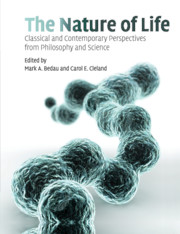Book contents
- Frontmatter
- Contents
- Preface
- Acknowledgments
- Sources
- About the authors
- Introduction
- SECTION I CLASSICAL DISCUSSIONS OF LIFE
- SECTION II THE ORIGIN AND EXTENT OF NATURAL LIFE
- 8 The origin of life: a review of facts and speculation
- 9 Small molecule interactions were central to the origin of life
- 10 Are the different hypotheses on the emergence of life as different as they seem?
- 11 The universal nature of biochemistry
- 12 Is there a common chemical model for life in the universe?
- 13 Searching for life in the universe: lessons from Earth
- 14 The possibility of alternative microbial life on Earth
- 15 Introduction to the limits of organic life in planetary systems
- SECTION III ARTIFICIAL LIFE AND SYNTHETIC BIOLOGY
- SECTION IV DEFINING AND EXPLAINING LIFE
- Supplementary bibliography on life
- Index
- References
15 - Introduction to the limits of organic life in planetary systems
Published online by Cambridge University Press: 10 November 2010
- Frontmatter
- Contents
- Preface
- Acknowledgments
- Sources
- About the authors
- Introduction
- SECTION I CLASSICAL DISCUSSIONS OF LIFE
- SECTION II THE ORIGIN AND EXTENT OF NATURAL LIFE
- 8 The origin of life: a review of facts and speculation
- 9 Small molecule interactions were central to the origin of life
- 10 Are the different hypotheses on the emergence of life as different as they seem?
- 11 The universal nature of biochemistry
- 12 Is there a common chemical model for life in the universe?
- 13 Searching for life in the universe: lessons from Earth
- 14 The possibility of alternative microbial life on Earth
- 15 Introduction to the limits of organic life in planetary systems
- SECTION III ARTIFICIAL LIFE AND SYNTHETIC BIOLOGY
- SECTION IV DEFINING AND EXPLAINING LIFE
- Supplementary bibliography on life
- Index
- References
Summary
THE SEARCH FOR LIFE IN THE COSMOS
The National Aeronautics and Space Administration (NASA) has long given high priority to missions that ask whether extraterrestrial life might exist in the solar system and beyond. That priority reflects public interest, which was enhanced in the mid 1990s when fragments of Mars delivered to Earth as meteorites were shown to contain small structures reminiscent of microbial life.
The proper interpretation of those structures remains controversial, but it is certain that nothing would alter our view of humanity and our position in the cosmos more than the discovery of alien life. Nothing would contribute more to NASA's goal of exploring the cosmos, or to inspiring and educating the next generation of students in the hard sciences and engineering, than a search for alien life. Nothing would be more unfortunate than to expend considerable resources in the search for alien life and then not recognize it if it is encountered.
The search for life in the cosmos begins with our understanding of life on Earth. This understanding has grown enormously over the past century. It is now clear that, although terran life is conveniently categorized into millions of species, studies of the molecular structure of the biosphere show that all organisms that have been examined have a common ancestry. There is no reason to believe, or even to suspect, that life arose on Earth more than once, or that it had biomolecular structures that differed greatly from those shared by the terran life that we know.
- Type
- Chapter
- Information
- The Nature of LifeClassical and Contemporary Perspectives from Philosophy and Science, pp. 210 - 216Publisher: Cambridge University PressPrint publication year: 2010



